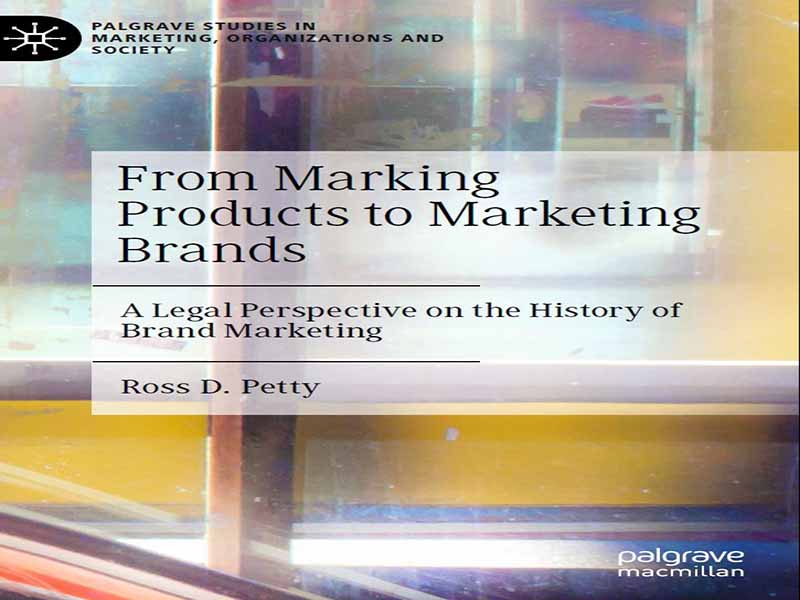- عنوان کتاب: From Marking Products to Marketing Brands
- نویسنده: Ross D. Petty
- حوزه: بازاریابی
- سال انتشار: 2025
- تعداد صفحه: 183
- زبان اصلی: انگلیسی
- نوع فایل: pdf
- حجم فایل: 7.45 مگابایت
امروزه بازاریابی برند مستلزم شناسایی آشکار برند و ارتقای خود برند است. تاریخچه با برندسازی حیوانات و چسباندن علامت های تجاری بر روی انواع دیگر محصولات شروع می شود. از لحاظ تاریخی، چنین علامت های تجاری کوچک بوده و چندان قابل توجه نبوده و با عدم تبلیغ علامت سازگار است. این کتاب سیر تکاملی را از علامتگذاری صرف برند تا بازاریابی برند نشان میدهد که در آن شناسههای برند برای توسعه تصویر یا شخصیت برند تبلیغ میشوند که خود فروش محصول یا خدمات مارک را تشویق میکند. تدلو (1990، 14) نامهای تجاری را «ابرنام» مینامد، زیرا آنها چیزی بیش از شناسایی نام محصول انجام میدهند، برندها خودشان برای ارائه اطلاعات در مورد محصول تبلیغ میشوند. در حالی که برخی از نویسندگان اصطلاح «برندسازی» را بدون تمایز نشانگذاری/شناسایی برند از تبلیغ خود برند استفاده میکنند (به عنوان مثال، Bastos & Levy، 2012)، این کتاب برندسازی هویت را از بازاریابی برند متمایز میکند تا تکامل تاریخی را از اولی به دومی بهتر نشان دهد. لازم به ذکر است که برخی از تاریخچه بازاریابی برند اغلب در متون تاریخ تبلیغات گنجانده شده و تا حدی در آن گنجانده شده است، زیرا بیشتر تبلیغات شامل محصولات و خدمات برند می شود (مانند Laird، 1998؛ لیرز، 1994؛ پاپ، 1983؛ ریچاردز، 2022؛ سامپسون، 1871، 389، 20، استراسر). مفهوم مدرن بازاریابی برند (در مقابل برندسازی) از مفهوم “تبلیغات علامت تجاری” در اوایل دهه 1900 تکامل یافته است. استرن (2006، 217) ادعا می کند که “برند” در سال 1922 به عنوان بخشی از ترکیب “نام تجاری” وارد واژگان بازاریابی شد، اما باستوس و لوی (2012، 353) پیشنهاد می کنند که اصطلاح نام تجاری حداقل تا سال 1920 رایج بوده است. آنها نمونه ای از نقل قول از P. T. Chering را ارائه می دهند. به قدری کلی شده است که در بسیاری از خطوط کالا به جای روش استثنایی فروش، مشخصه است. بازاریابی برند ممکن است به ویژه در شرایطی که ارزیابی مشتری از ویژگی های محصول دشوار است مؤثر باشد. اقتصاددانان معتقدند که برخی از جنبه های یک محصول ممکن است به آسانی توسط مصرف کنندگان قبل از خرید مشاهده و ارزیابی شوند. به این صفات جستجو می گویند. به عنوان مثال، قیمت محصول معمولاً یک ویژگی جستجو است. سایر ویژگی ها ممکن است به آسانی پس از استفاده ارزیابی شوند (ویژگی های تجربه). تبلیغ نام تجاری ممکن است میانبر مفیدی برای مصرف کنندگان باشد، اما یک تجربه بد ممکن است باعث شود مصرف کنندگان برند را از بررسی های آینده حذف کنند. برخی از ویژگی ها (اعتبار) ممکن است به راحتی توسط مصرف کنندگان ارزیابی نشود، مانند مزایای سلامتی طولانی مدت مصرف یک مارک مولتی ویتامین. بازاریابی برند ممکن است به ویژه برای محصولاتی که ویژگیهای اعتباری آنها غالب است مفید باشد، زیرا مصرفکنندگان جنبههای منفی چنین محصولاتی را برای قطع دلبستگی مصرفکننده به برند تجربه نمیکنند.
Today, brand marketing involves conspicuous brand identification and promotion of the brand itself. The history starts with branding animals and affixing brand markings on other sorts of products. Historically, such branding marks have been small and not very noticeable consistent with a lack of promotion of the mark. This book traces the evolution from mere brand marking to brand marketing where the brand identifiers are promoted to develop the brand’s own image or personality that itself encourages sales of the branded product or service. Tedlow (1990, 14) calls brands “supernames” because they do more than just identify the product name, brands are promoted themselves to provide information about the product. While some authors use the term “branding” without distinguishing brand marking/identification from promotion of the brand itself (e.g., Bastos & Levy, 2012), this book distinguishes identity branding from brand marketing to better illustrate the historical evolution from the first to the second. It should be noted that some of the history of brand marketing is often included and partially subsumed in the literature on the history of advertising since most advertising involves branded products and services (e.g., Laird, 1998; Lears, 1994; Pope, 1983; Richards, 2022; Sampson, 1874; Strasser, 1989; Tungate, 2013). The modern concept of brand marketing (as opposed to branding) evolved from the concept of “trademark advertising” in the early 1900s. Stern (2006, 217) claims “brand” entered the marketing lexicon in 1922 as part of the compound “brand name” but Bastos and Levy (2012, 353) suggest that the term brand was in common usage at least by 1920. They provide an example of a quote from P. T. Cherington (1920, 150): “the appeal to the buy… by brand has become so general as to be in many lines of merchandise the characteristic rather than the exception method of sale.” Brand marketing may be particularly effective in situations where consumer evaluation of product attributes is difficult. Economists posit that some aspects of a product may be readily observed and evaluated by consumers before purchase. These are called search attributes. Product price, for example, is usually a search attribute. Other attributes may be readily evaluated upon use (experience attributes). Promoting the brand may be a useful short-cut for consumers, but one bad experience may cause consumers to eliminate the brand from future consideration. Some attributes (credence) may not be readily evaluated by consumers at all such as long-term health benefits from taking a brand of multivitamin. Brand marketing may be particularly useful for products dominated by credence attributes because consumers won’t experience negative aspects of such products to interrupt consumer attachment to the brand.
این کتاب را میتوانید از لینک زیر بصورت رایگان دانلود کنید:




































نظرات کاربران